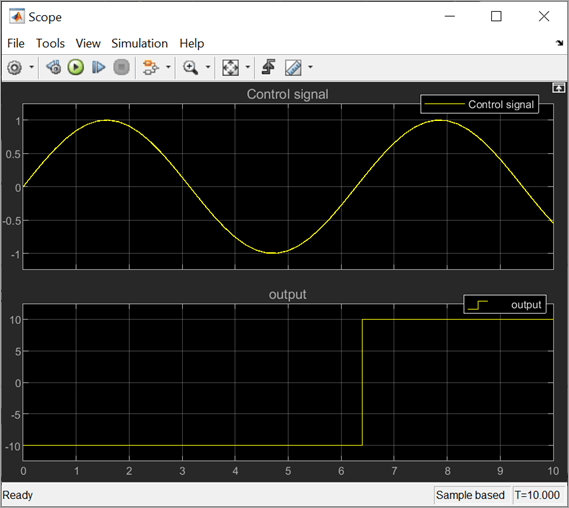모델 참조
다른 모델에서 블록으로 모델을 재사용
모델 참조는 Model 블록을 사용하는 다른 모델에 대한 참조입니다. 이러한 참조는 모델 계층 구조를 생성합니다. 참조된 각 모델에는 정의된 인터페이스가 있으며, 이 인터페이스는 그 입력 및 출력의 속성을 지정합니다. 정의된 인터페이스에 의한 참조된 모델의 동작은 모델 계층 구조의 맥락과는 독립적입니다. 모델 참조는 코드 재사용, 단위 테스트, 병렬 빌드, 대규모 컴포넌트에 이상적입니다. 파일 경합 및 병합 문제도 줄일 수 있습니다.
참조된 모델이 모델링 요구 사항을 충족하는지 확인하려면 컴포넌트 기반 모델링 지침 항목을 참조하십시오.
모델 참조 계층 구조에 대한 코드 생성을 학습하려면 Referenced Models (Simulink Coder) 항목을 참조하십시오.
보호 모델을 생성하려면 Model Protection (Simulink Coder) 항목을 참조하십시오.
모델 참조 계층 구조에 대한 SIL/PIL 테스트를 수행하려면 SIL and PIL Simulations (Embedded Coder) 항목을 참조하십시오.
블록
| Model | Reference another model to create model hierarchy |
| Variant Subsystem | Template subsystem containing Subsystem blocks as variant choices |
함수
모델 설정
툴
| 모델 참조 변환 어드바이저 | Convert subsystems to referenced models |
| 참조 파일 창 | View, save, and close referenced subsystems and models |
도움말 항목
모델 참조 시점 결정하기
- 컴포넌트 기반 모델링 지침
대규모 모델 및 다중 사용자 개발 팀을 위한 컴포넌트화를 고려합니다. - Model Reference Behavior and Capabilities
Decide whether to reference one model in another model and how to implement this model reference. - Model Reference Requirements and Limitations
Model references have requirements and limitations relating to features such as reusability, simulation modes, masking, and debugging.
모델 참조 만들기
- Reference Existing Models
Include a model in another model. - Reference Protected Models from Third Parties
Use a protected model that you received from a third party. - Convert Subsystems to Referenced Models
Prepare a subsystem for conversion, convert the subsystem to a model, and compare simulation results before and after conversion. - Define Model Reference Interfaces
Ports in the referenced model correspond with ports at the model reference. Signals that cross the model boundary must meet certain requirements. - Inspect Model Hierarchies
Examine the contents, structure, model versions, and logged signals in a model hierarchy.
모델 참조 구성하기
- Set Configuration Parameters for Model Hierarchies
Configuration parameter values can be different in top models and referenced models. Some configuration parameter values have special requirements or behavior with model referencing. - Conditionally Execute Referenced Models
Execute referenced models conditionally, similar to conditionally executed subsystems. - Referenced Model Sample Times
A referenced model can inherit sample times from the model that references it. - Configure Instance-Specific Values for Block Parameters in a Referenced Model
When you model a reusable component as a referenced model, to configure each instance of the component to use different values for block parameters, create model arguments. - Parameterize a Referenced Model Programmatically
This example shows how to programmatically configure multiple instances of a referenced model to use different values for the same block parameter. - Group Multiple Model Arguments into a Single Structure
This example shows how to programmatically configure multiple instances of a referenced model to use different values for the same block parameter by using structures. - Configure Instance-Specific Data for Lookup Tables Programmatically
When you useSimulink.LookupTableobjects to store and configure lookup table data for ASAP2 or AUTOSAR code generation (for example, STD_AXIS or CURVE), you can configure the objects as model arguments.
모델 계층 구조 시뮬레이션하기
- Choose Simulation Modes for Model Hierarchies
Select the simulation mode for models in a model hierarchy. - Manage Simulation Targets for Referenced Models
A simulation target, or SIM target, is a MEX file that implements a referenced model that executes in accelerator mode. - 더 빠른 시뮬레이션을 위해 Simulink 캐시 파일 공유하기
Simulink 캐시 파일을 사용하여 처음 빌드 때의 비용이 다시 발생하지 않도록 해 주는 빌드 아티팩트를 공유합니다. - Override Model Reference Simulation Modes
When a top model simulates in normal mode, you can override the simulation mode used for model references without dirtying their parent models. - Reduce Update Time for Referenced Models by Using Parallel Builds
Reduce diagram update time for large model reference hierarchies by using parallel builds. - Simulate Conditionally Executed Referenced Models
Run a standalone simulation of a conditionally executed referenced model. - Simulate Multiple Referenced Model Instances in Normal Mode
Simulate a model that contains multiple instances of a referenced model.
관련 정보
- 컴포넌트 기반 모델링
- 협업 모델링
- Variant 시스템
- Referenced Models (Simulink Coder)
- Model Protection (Simulink Coder)






